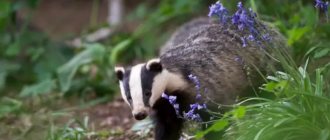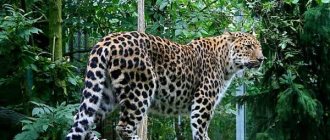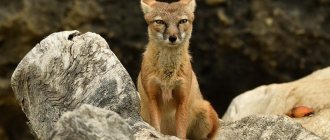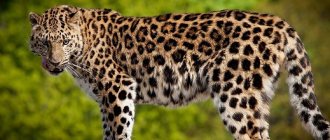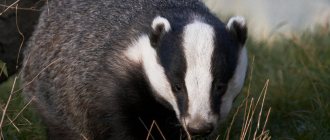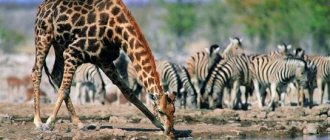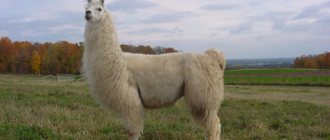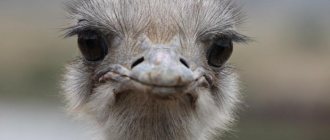WHAT DOES IT EAT?
The honey badger is extremely unpretentious in terms of food. Anything he can catch or discover is suitable for him to eat: small mammals and birds, fish, lizards, frogs, poisonous snakes, say, cobras, scorpions and other insects. Facts of honey badger attacks on domestic sheep have also been recorded. Because of this, people strive to exterminate this pest whenever possible. The honey badger supplements its hunting diet with gathering and in this case eats bird eggs, berries, fruits, roots and buds of plants - it is difficult to find something that it would refuse.
The honey badger loves honey - that's where its name comes from - and destroys the hives of wild bees to get it. Also, when hunting, he tears apart the holes of meerkats, hamsters, rats and mice - the fate of the inhabitants of these holes is unenviable! The honey badger does not disdain carrion.
Subspecies
- Mellivora capensis capensis (Schreber, 1776)
- Mellivora capensis indica (Kerr, 1792)
- Mellivora capensis inaurita (Hodgson, 1838)
- Mellivora capensis buechneri (Baryshnikov, 2000) is a new subspecies discovered in Turkmenistan in 2000. Similar to subspecies M. c. indica and M. c. inaurita, but there are also differences with them, including the fact that it is larger.
LIFESTYLE
The honey badger is nocturnal. During the day he sleeps in a hole or hollow, and in the evening he goes hunting. In spring, the honey badger also exhibits daytime activity - this is due to the bark period. The honey badger builds burrows similar to those of a badger. Near his hiding place, like the badger hole, there is a permanent dressing room. The depth of the burrows varies from one to three meters. Often the old dwellings of these animals eventually turn into a whole town. The African honey badger often lives in tree hollows instead of burrows. Very rarely they can settle in rock crevices. Although the honey badger is an excellent tree climber, it climbs there only when it wants to feast on honey from a hive of wild bees located on a tree.
The honey badger is considered one of the most fearless and aggressive animals - despite its small stature, the honey badger bravely fights against a leopard and even a lion! The honey badger is especially aggressive during the mating season. In a fight, the honey badger bites into the body of the enemy and hangs on him like a bulldog. The honey badger's gait looks strange - it seems as if the animal is fawning, pressing itself to the ground and arching its back. If necessary, this animal can gallop over long distances. An angry honey badger raises its tail threateningly to intimidate its opponent.
Honey badgers are solitary animals that meet with an individual of the opposite sex only during intercourse during the mating season. Only then can you see a pair of honey badgers nearby.
Nutrition
Honey badgers have the most varied diet of any animal in the mustelidae family. In wilder areas, honey badgers can hunt at any time of the day, but in areas with large human populations they become nocturnal. When hunting, a honey badger trots at the same speed as a young man. Despite their name, honeyeaters are primarily carnivores and feed on all types of animal food, including carrion: small rodents, scorpions, birds, eggs, insects, lizards, snakes, turtles and frogs. If necessary, eat fruits and vegetables, as well as roots and bulbs.
They can hunt frogs and rodents such as gerbils and ground squirrels by digging them out of burrows. They easily eat turtles thanks to their strong jaws. They kill and eat snakes, even very poisonous and large ones, such as cobras. There are known cases of digging up human corpses in India. They devour prey completely, including skin, hair, feathers, flesh and bones, holding the food with their paws. When searching for plant food, they lift stones or tear off bark from trees.
DID YOU KNOW THAT...
- In arid areas near dry river beds, honey badgers dig holes into which water collects over time. These watering holes are also popular with other animals. Elephants also dig such holes during drought.
- The honey badger is also known as the Indian honey badger, bald badger and ratel.
- The honey badger is able to hunt turtles without being at all embarrassed by the presence of their durable shell.
- The skin of the honey badger is quite loosely attached to its body due to the presence of a layer of subcutaneous fat. Therefore, if a honey badger is attacked from behind, it can easily turn around and attack the enemy.
Description and characteristics
The honey badger has a rather elongated body, but is very stocky and wide in the back. His skin is amazingly loose and allows him to turn freely in it. The skin around the neck is 6mm thick and is an adaptation for fighting off competitors. The head is small and flat, with a short muzzle. The eyes are small and the ears are slightly larger than slits, probably another adaptation to avoid injury during skirmishes with leopards and lions.
The honey badger has short and strong legs, with five toes on each foot. The paws are armed with very strong claws, which are shorter on the hind limbs and noticeably longer on the forelimbs. It is a walking animal with thick pads on its feet. The tail is short and covered with long hair except at the base.
Honey badger skeleton
Adults are from 23 to 28 cm at the withers and from 68 to 75 cm in length (excluding tail), females are smaller than males. Males weigh from 12 to 16 kg, females - 9.1 kg. The length of the skull is 13.9–14.5 cm in males and 13 cm in females.
Area
They have two pairs of nipples. The honey badger has an anal sac, which is rare in animals of the mustelidae family. The smell of the bag is suffocating and helps to calm the bees during raids on the hives.
The skull bears little resemblance to that of a common badger and in many ways resembles an enlarged version of the bandage skull. The skull is very hard and in adults there is no trace of independent bone structure. The skull is wider than that of dogs.
Honey badger and various types of badgers
Dental formula 3.1.3.1/3.1.3.1. Teeth often show signs of maldevelopment, with some being very small, positioned at odd angles, or missing altogether. The fangs are very short for a carnivore. The tongue is sharp and has prominent papillae that help digest tough foods.
Winter fur is long (40–50 mm in the lumbar region) and consists of sparse, coarse, bristly hairs without underfur under the awn. On the sides, on the stomach and in the groin, the hair is even rarer. In summer, the coat is shorter (only 15 mm on the back) and even less frequent, and the belly is half naked. The muzzle, sides of the head and lower part of the body are pure black. Starting from the top of the head and ending with the base of the tail, a wide white stripe covers the upper side of the body. Honeyeaters of the subspecies cottoni are unique in that they are completely black.
HONEY EATER AND HONEY MANDATOR
The honey badger is known for its collaboration with the honey bird or honey guide. This bird finds a nest of wild bees and brings the honey badger to it in order to pick up the scraps from his table. The honey badger gets to the nest and tears it apart with its strong claws. He eats the honey and leaves the honeycomb for the bird, which eats not only the larvae, but also the wax.
— Honey badger range
HABITAT
It is found in South and Central Africa, Near and Central Asia up to and including the Hindustan Peninsula.
PRESERVATION
Now the species is not in danger of extinction, however, the number of honey badgers has decreased due to the destruction of their habitats.
Honey badger
The honey badger (lat. Mellivora capensis) is a fairly large representative of the mustelid family, which is so unusual that it belongs to a separate subfamily and genus. Its average weight is 9-13 kg, body length 95-105 cm, including a 25 cm black tail. It has the same elongated body as a badger, and the same disproportionately short legs.
flickr/westie14500
True, this is where the external similarity ends. The honey badger has a slightly blunt muzzle and no ears at all. The top of the head, sides and back are dirty white, there are no black stripes near the eyes, but the belly, paws and tail are covered with shiny black hair. This coloration makes it possible to camouflage among desert salt marshes. In Africa, where honey badgers are found almost everywhere, they are called bald badgers, and in Turkmenistan and Central Asia - dog bears.
flickr/honeybadger619
By the way, precisely “canine”, and then “knowing about honey”, since the basis of their diet is animal food: ferrets, turtles, lizards, monitor lizards, snakes and even small sheep. Sometimes eats insects and carrion. It does not particularly readily eat berries and fruits. Honey, like a true delicacy, is not available to these animals very often. For his sake, enterprising predators are ready to climb a tall tree or climb into a “civilized” hive.
flickr/Tickspics
Sometimes in these forays the honey badgers are helped by a small bird from the order of woodpeckers, which is called the honey guide. Having discovered a beehive, she tries in every possible way to attract the attention of a stronger assistant with a special whistle. The honey badger rises to the home of social insects, fumigates them with its fetid odor and, without a twinge of conscience, destroys the nest.
flickr/Arno & Louise Wildlife
Of course, especially resistant bees desperately resist, trying to sting the impudent one, but its unusually thick skin makes it easy to withstand such attacks. The honey guide picks up the remains of the meal, eating bee larvae and wax.
flickr/Ulli J.
True, contrary to the erroneous opinion, there is no symbiosis between the animal and the bird, and the sluggish short-legged one is often overtaken by local aborigines, who are also not averse to getting some wild honey.
flickr/Matt1962
The honey badger also hunts animals in a unique way: slowly moving along the ground, it presses almost completely against it, sniffing out its prey. Sensing a ferret or turtle, the predator quickly tears up the soil with its long claws, which grow throughout its life. If the future meal is hidden very close, the honey badger confines itself to a small funnel, but if the prey has gone deep under the surface, the animal can dig a long tunnel in just a few minutes.
flickr/seancrane
The same tunnels also serve as a shelter for the honey badger. They go 1-3 meters deep and end in an ordinary earthen bag without bedding. Even females do not consider it necessary to arrange their own housing too much, preferring to constantly transfer the cub from one hole to another.
flickr/Ulli J.
Mating among honey badgers continues all year round, pregnancy lasts 6 or 7 months, and 1-2 naked and helpless babies are born in the litter. The mother takes care of them independently, since these animals do not create permanent pairs. The children stay with her for a little less than a year, learning the intricacies of honey badger life.
flickr/safariman2011
Looking at the funny little ones, it’s hard to believe that they grow up to be one of the most aggressive and fearless animals in the jungle, who are not afraid even of buffalos. Local residents have repeatedly witnessed fights between honey badgers and lions or leopards. Of course, the small animal has practically no chance, but it sacrifices its own life dearly. Their ferocious temperament and omnivorous nature makes honey badgers similar to wolverines.
flickr/Ulli J.
In addition, these animals have a curious reaction to cobra venom. What kills others in minutes only leaves the honey badger sick for two hours. True, the animal really feels bad - its body even convulses violently for some time. But the quills of the porcupine do not bother the honey badger at all, just like the bites of many insects - the predator is protected by its skin and a decent layer of fat.
flickr/Giovanni Mari
At the moment, the number of honey badgers is gradually declining - as a result of the declared war on the part of African farmers who do not want to share their poultry with the nosy predators.
+ video...

